
By mid-1986, it was clear that no existing operating system (OS) would be able to meet their tentative specification for an object-oriented programming environment and user interface. This forced a major change in the business plan: not only would NeXT create an object-oriented programming environment, they would need to build hardware and a Unix-like Mach-based OS for the toolkit to run on. A team led by Avie Tevanian, one of the Mach engineers at Carnegie Mellon University who had since joined the company, were to develop the operating system, whilst the hardware division led by Rich Page, one of the cofounders who had previously led the Apple Lisa team, were to develop and design the hardware. The name of the company was changed to NeXT Computer, Inc..

The NeXT Computer was slower than many Unix workstations becoming available at that time, but cost about half as much[citation needed]. It included 8 MB of random access memory (RAM), a 256 MB MO drive, Ethernet, NuBus and a 17-inch MegaPixel grayscale display measuring 1120×832 pixels. Meanwhile, a typical PC included 640 KiB of RAM, the 8086, 8088, 286 or 386 CPU, a 640×350 16-color or 720×348 monochrome display, a 10 to 20 megabyte hard drive and no networking capabilities.

The NeXT Computer used by Tim Berners-Lee at CERN became the world's first Web server
1 yorum:
first internet page, magical...
i envy those guys with such talents...
NeXT was a good companion.
Yorum Gönder